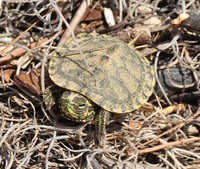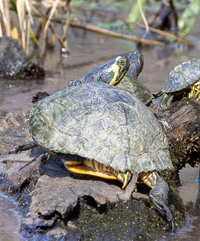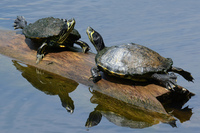Taxonomy
Class: ReptiliaOrder: TestudinesFamily: EmydidaeSubfamily: Deirochelyinae
Taxonomic Comments: See species accountSpecies Comments: See species account
Identification
Basis for Records: Well-marked juveniles and adults can be identified from photographs. Older, darkened adults can also be identified by the morphological characteristics of the carapace. A good close-up frontal view of the mouth is also sufficient to identify a specimen at least to the genus.Field Marks: The Yellow-bellied Slider can usually be identified by the large yellow blotch located behind the eye and by the series of vertical yellow stripes located on the rear of the thighs and body next to the tail. The Red-eared Slider typically has an elongated patch of red on the rear of the head and lacks a yellow patch behind the eye. The carapace of the Yellow-bellied Slider is typically dark greenish or brownish and has vertical stripes of yellow on each of the pleural scutes. Juveniles are much paler yellowish than the adults and have a series of knobs on their dorsal keel. Old individuals, particularly males, can become melanistic, with much of the key markings used to identify them obscured.Morphological Features: See species account; apart from differences in markings, there do not appear to be any morphological features that separate the three subspecies. Maximum lengths recorded for this subspecies in North Carolina are: 10.5" (267mm), females, and 9.3" (235mm), males (Palmer and Braswell, 1995).Technical Reference: Palmer and Braswell (1995); Ernst and Lovich (2009)Field Guide Descriptions: Beane et al. (2010); Powell et al. (2016)Online Photos: Google iNaturalist GBIF Observation Methods: This species is most often seen basking on rocks or logs. The yellow patch on the side of the head is often visible in swimming individuals.
Distribution in North Carolina
Distribution Comments: This species is most common in the Coastal Plain but occurs in several counties that border the Fall-line on the west. On the barrier islands, it has been recorded from Nags Head Woods to Hatteras Island in Dare County and on Ocracoke Island in Hyde County (Palmer and Braswell, 1995).Distribution Reference: Palmer and Braswell (1995); NCMNS Herpetology Collection Database (accessed 2023-01)County Map: Clicking on a county returns the records for the species in that county.
Key Habitat Requirements
Habitat: Yellow-bellied Sliders inhabit ponds, sloughs, canals and other well-insolated still or sluggish waters in both the Coastal Plain and eastern Piedmont (Palmer and Braswell, 1995). Soft-bottomed habitats with abundant aquatic vegetation are preferred (Camper, 2019)Environmental and Physiological Tolerances: Yellow-bellied Sliders are primarily southeastern, with their northern limit in Virginia. Cold winter temperatures may therefore be limiting, which may explain their concentration in the Coastal Plain in North Carolina. During droughts, individuals will leave their ponds as they dry out and move overland to other water bodies rather than use upland refuges as is done by other species of turtles (Ernst and Lovich, 2009).Biotic Relationships: Juveniles are carnivorous but adults are omnivorous, feeding on algae, aquatic macrophytes, many species of aquatic invertebrates, and tadpoles, fish, frogs, and snakes as well as carrion (Camper, 2019). Juveniles are eaten by fish, large frogs, nakes, herons and other birds, raccoons and other predatory mammals. Large adults are preyed upon by Alligators (Palmer and Braswell, 1995).
Life History and Autecology
Breeding and Courtship: Courtship and mating takes place in the spring. Males use their long front claws in courtship displays, stroking the face and chin of the females.Reproductive Mode: Egg-laying has been observed in North Carolina in May, June, and July (Palmer and Braswell, 1995). Up to 12 eggs have been found in a nest. Juveniles may overwinter in the nest.Aquatic Life History: This species has been observed in every month of the year but is most active in the spring and summer (Palmer and Braswell, 1995). In addition to foraging, basking is an important daily activity, involved in thermoregulation; smaller turtles spend more time basking than do larger individuals (Ernst and Lovich, 2009). They can also stay submerged for long periods, with a number of physiological adaptations for dealing with anoxia (see Ernst and Lovich for details of their physiology). Terrestrial Life History: Females nest in sandy areas near water and individuals will travel overland when their ponds start to dry out (Ernst and Lovich, 2009). Cagle (1944) found that individuals (of T.s.elegans) may include several different water bodies within their home ranges, between which they may make frequent journeys. Other overland trips are made by males to search for mates. While sliders have home ranges, they may or may not make any attempt to home if they are displaced. Males move further than females, presumably in search of mates. Territories as such are not defended, but aggressive behavior has been observed between males and between individuals making use of a single basking site; larger individuals are more successful in resisting displacement than smaller ones.
General Ecology
Adverse Environmental Impacts
Habitat Loss: Habitat for this species may actually be increasing due to the return of beaver ponds to the North Carolina landscape.Habitat Fragmentation: Construction of reservoirs on the main rivers within the range of this species probably does not impede the movements of this species, which makes use of lentic as well as lotic habitats. Roads are probably much more significant barriers to movements, but given the apparent low requirement for overland movements in this species, may not be as much of a fragmenting factor as it is for other species of reptiles.Effects of Introduced Species/Induced Increases of Native Species: Genetically, this species is at risk due to widespread interbreeding with the invasive Red-eared Slider. Nests are also vulnerable to predation by the Imported Red Fire Ant (Buhlman and Coffman, 2001).Interactions with Humans: Adults are frequently shot while basking and are highly vulnerable to being killed when crossing roads. There is also some concern that they may be overharvested for the Asian turtle market (Camper, 2019).
Status in North Carolina
NHP State Rank: S5T3T4Global Rank: G5Status in North Carolina: The species itself appears to be secure in the state but the identity of the Yellow-bellied Slider as a distinct subspecies seems questionable, given the spread of intergrades with the Red-eared Slider. This is reflected in our use of T3S4 to indicate the status of the subspecies, which is different from the status of the species, which is ranked as S5.
Photo Gallery for Trachemys scripta scripta - Yellow-bellied Slider 21 photos are shown. Recorded by: K. Sanford Recorded by: K. Sanford Recorded by: K. Sanford Recorded by: Steve Hall, Carol Tingley, and David George Recorded by: Steve Hall, Carol Tingley, and David George Recorded by: Steve Hall, Dee Stuckey, Savannah Hall, Cheryl Stuckey Recorded by: Steve Hall, Dee Stuckey, Savannah Hall, Cheryl Stuckey Recorded by: Steve Hall, Dee Stuckey, Savannah Hall, Cheryl Stuckey Recorded by: J. Stark Recorded by: Steve Hall and Dee Stuckey Recorded by: Steve Hall Recorded by: Terrell Tucker Recorded by: K. Bischof Recorded by: K. Bischof Recorded by: K. Sanford Recorded by: K. Sanford Recorded by: K. Sanford Recorded by: Mark Shields Recorded by: Mark Shields Recorded by: Mark Shields Recorded by: Mark Shields

 »
» 





 »
» 



